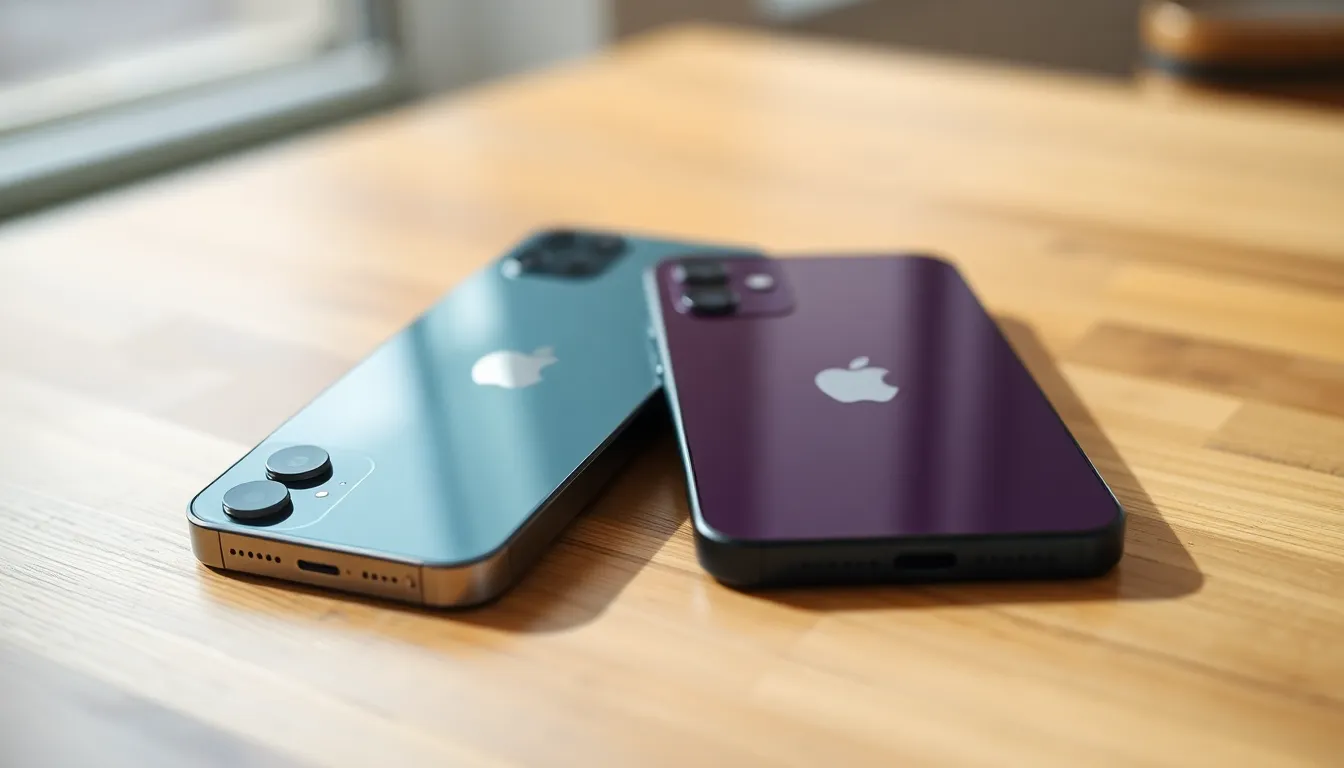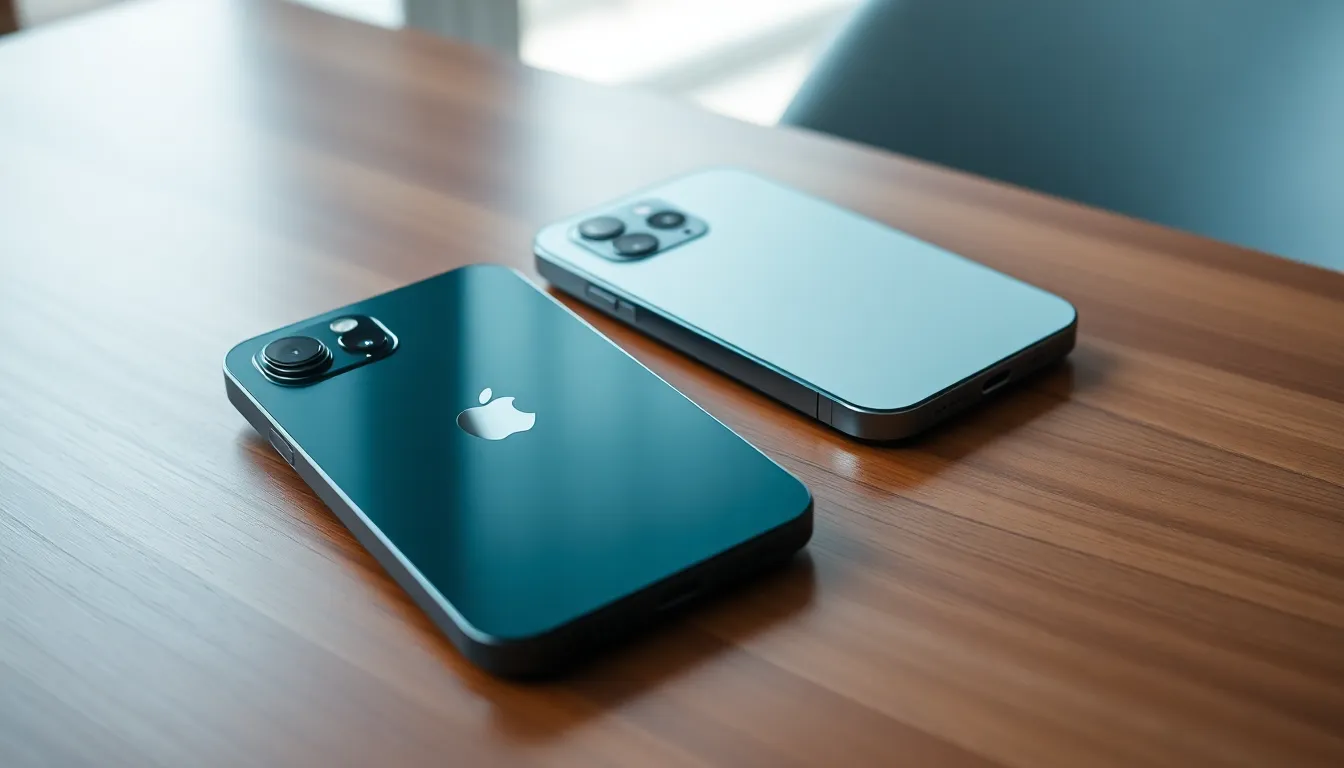When it comes to smartphones, Apple always knows how to keep the excitement alive. The iPhone 13 and iPhone 14 might seem like they’re just a generation apart, but the differences can feel as vast as the Grand Canyon. Are you ready to dive into the tech world and find out if upgrading is worth it? Spoiler alert: it might be more thrilling than binge-watching your favorite series!
Table of Contents
ToggleDesign Comparisons
Design plays a crucial role in distinguishing the iPhone 13 from the iPhone 14. Both models exhibit Apple’s renowned aesthetic, yet key differences exist.
Size and Weight
The iPhone 13 measures 146.7 x 71.5 x 7.65 mm and weighs 174 grams. In contrast, the iPhone 14 has the same dimensions but is slightly heavier at 172 grams. Both models maintain a comfortable size, making them easy to handle. Despite the minor changes in weight, the feel in hand remains very similar. Users often prioritize portability, and both phones deliver in this regard. Subtle adjustments ensure that the iPhone 14 remains attractive without altering the overall experience drastically.
Color Options
Color options also set the two models apart. The iPhone 13 comes in six colors: Product Red, Starlight, Midnight, Blue, Pink, and Green. Meanwhile, the iPhone 14 introduces a new palette with colors like Purple, Blue, Midnight, Starlight, and Red. This addition emphasizes personalization, allowing users to choose colors that reflect their style. Diversified shades attract varying preferences, appealing to a broader audience. Ultimately, these color variations enhance the visual appeal of the devices, reinforcing the individuality of each model.
Performance Upgrades

The performance differences between the iPhone 13 and iPhone 14 stand out considerably. Enhanced capabilities in the newer model make it a compelling choice for many users.
Chipset Differences
iPhone 14 features the A16 Bionic chip, while the iPhone 13 uses the A15. This newer chipset provides significant improvements in processing speed and graphics performance. Up to 30% faster CPU performance in the iPhone 14 enables smoother multitasking. Enhanced machine learning capabilities in the A16 lead to better camera functionality and improved app performance. Users will notice the difference, especially in resource-intensive applications and gaming scenarios.
Battery Life
Battery life shows noticeable improvement in the iPhone 14 compared to the iPhone 13. With up to 20 hours of video playback, the iPhone 14 surpasses the iPhone 13, which offers around 19 hours. Optimized power efficiency paired with the A16 chip contributes to this enhancement. Charging efficiency also received boosting, allowing quicker top-ups. For users who depend heavily on their phones throughout the day, this upgrade matters significantly.
Camera Features
Camera specifications mark a key difference between the iPhone 13 and iPhone 14. Upgrades enhance photography and videography capabilities, appealing to users who value these features.
Rear Camera Enhancements
Rear camera improvements stand out in the iPhone 14. It boasts a larger sensor that allows for increased light capture, resulting in brighter images, especially in low-light settings. The new Photonic Engine offers advanced image processing, enhancing details and colors significantly. Night mode performance also benefits from these enhancements, producing clearer and more vibrant shots. Furthermore, the iPhone 14 introduces Action mode for smoother video stabilization, making it ideal for capturing dynamic scenes. These changes solidify the iPhone 14’s position as a top choice for photography enthusiasts.
Front Camera Improvements
Front camera upgrades on the iPhone 14 enhance the user experience. A 12 MP TrueDepth camera features autofocus for sharper selfies and clearer video calls. This model introduces an improved Night mode, creating well-lit images even in dim environments. Additionally, the inclusion of Cinematic mode allows users to shoot with rack focus effects, adding a professional touch to videos. Enhanced capabilities for FaceTime yield improved resolution and clarity during video calls. The iPhone 14’s front camera elevates social media content creation, meeting the demands of modern users.
Display Specifications
Display specifications play a crucial role in user experience for smartphones. Both the iPhone 13 and iPhone 14 feature Super Retina XDR displays, ensuring vibrant colors and sharp images.
Screen Technology
Super Retina XDR technology enhances visual quality in both models. The iPhone 14, however, offers improved color accuracy and contrast over the previous generation. Each device uses OLED technology, yet the iPhone 14 adds support for ProMotion with adaptive refresh rate features, providing smoother scrolling and responsiveness. This enhancement boosts overall user interaction, particularly for gaming and media consumption.
Brightness and Resolution
Brightness and resolution significantly impact visibility in various lighting conditions. The iPhone 13 boasts a peak brightness of 1200 nits for HDR content. Comparatively, the iPhone 14 improves brightness capabilities, reaching 2000 nits peak outdoors. Both models maintain a resolution of 2532 x 1170 pixels, delivering exceptional clarity and detail. Enhanced outdoor visibility in the iPhone 14 makes it particularly appealing for users who often use their devices outside.
Software and Features
Both the iPhone 13 and iPhone 14 run on Apple’s iOS, yet subtle differences exist in software experiences between the two models.
iOS Differences
iOS 15 powers the iPhone 13, while the iPhone 14 features iOS 16. Enhanced customization options in iOS 16 include richer notification management and improved focus modes. Updates on the iPhone 14 allow for more seamless multitasking and refined privacy features. Device owners notice quicker access to widgets, streamlined app management, and enhanced share capabilities. A more intuitive experience awaits iPhone 14 users with features such as Live Text in videos and advanced face recognition in photos.
New Features in iPhone 14
New functionalities in the iPhone 14 further distinguish it from its predecessor. Crash Detection introduces safety measures, automatically contacting emergency services during severe accidents. Photonic Engine technology enhances photo processing for better clarity and detail in captures. Additionally, the iPhone 14 supports enhanced video recording features, including Action mode for smoother shooting on the move. Emergency SOS via satellite provides an invaluable safety option, allowing users to connect when cellular service isn’t available. Enhanced capabilities solidify the iPhone 14’s position as an innovative smartphone choice.
Price and Availability
Price and availability details for the iPhone 13 and iPhone 14 are critical for potential buyers. Both models offer unique features, yet pricing reflects their respective positions in the market.
Pricing Comparison
Pricing for the iPhone 13 starts at $699 for the base model with 128GB of storage. In contrast, the iPhone 14 begins at $799 for the same storage capacity. Higher storage options increase the price; the iPhone 13 goes up to $899 for 256GB, while the iPhone 14 costs $899 for the 512GB version. Users interested in purchasing should consider any promotional offers from carriers or retailers, as these can influence the overall cost. Apple’s pricing strategy may vary based on demand and market trends, impacting the decision to upgrade.
Release Dates
The iPhone 13 launched on September 24, 2021, creating significant buzz in the tech community. In comparison, the iPhone 14 debuted on September 16, 2022, shortly after its announcement event. With the annual release cycle, the iPhone series generally sees a new model introduced every September. Continuously, the timing aligns with consumer demand for the latest technology, ensuring that users can access new features and enhancements as soon as they become available. Both models remain in circulation, providing options for users exploring upgrades or first-time purchases.
Choosing between the iPhone 13 and iPhone 14 ultimately depends on individual needs and preferences. The iPhone 14 clearly offers significant advancements in performance camera quality and software features that cater to tech-savvy users. For those who prioritize enhanced photography and multitasking capabilities the newer model stands out as a compelling upgrade.
However the iPhone 13 remains a solid choice for users seeking reliability and style without the latest enhancements. Its performance is still commendable making it suitable for everyday tasks. Weighing the differences in design features and pricing will help users make an informed decision that aligns with their lifestyle and budget.




